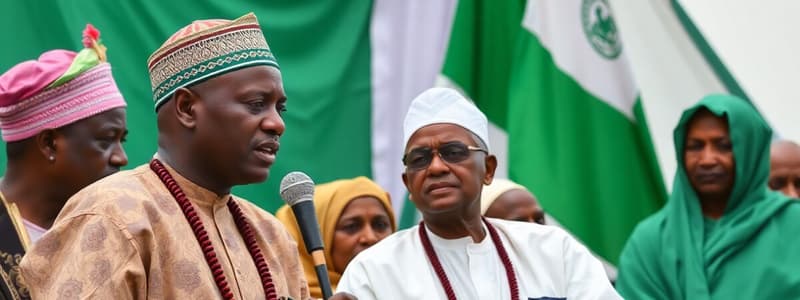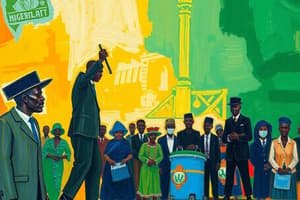Podcast
Questions and Answers
What is the effect of forced unity on national unity according to the content?
What is the effect of forced unity on national unity according to the content?
- It strengthens social cohesion.
- It promotes harmonious cooperation.
- It generates greater social strife and alienation. (correct)
- It has no significant impact.
What does the Sixth Schedule status for the GNLF-led Darjeeling Gorkha Hill Council signify?
What does the Sixth Schedule status for the GNLF-led Darjeeling Gorkha Hill Council signify?
- Restructuring of the municipal governance in Darjeeling.
- A reduction of autonomy for local governments.
- An increase in central control over the region.
- Greater autonomy for the governing body in the Hill district. (correct)
Which event is directly related to federalism functioning in India?
Which event is directly related to federalism functioning in India?
- Action plan requested for rain-hit States by the Centre.
- Conversion of Manipur University into a Central University.
- Announcement of a new municipal commissioner for Delhi.
- Funds released under the rural water supply scheme for Arunachal Pradesh. (correct)
What implication does the signed tripartite Memorandum of Settlement have?
What implication does the signed tripartite Memorandum of Settlement have?
What is a potential challenge to national unity highlighted by the content?
What is a potential challenge to national unity highlighted by the content?
Which ethnic group is associated with the Northern region of Nigeria?
Which ethnic group is associated with the Northern region of Nigeria?
What was one significant outcome of the conflicts among Nigeria's ethnic groups?
What was one significant outcome of the conflicts among Nigeria's ethnic groups?
What was not allowed under the military-supervised constitution of 1979 in Nigeria?
What was not allowed under the military-supervised constitution of 1979 in Nigeria?
What continues to present issues for the Nigerian federation after the restoration of democracy in 1999?
What continues to present issues for the Nigerian federation after the restoration of democracy in 1999?
What was a primary concern for Indian leaders before Independence regarding governance?
What was a primary concern for Indian leaders before Independence regarding governance?
What was debated during the negotiations before Partition regarding regional powers?
What was debated during the negotiations before Partition regarding regional powers?
How did Indian leaders plan to govern a diverse country like India?
How did Indian leaders plan to govern a diverse country like India?
What was the ultimate goal of regional governance according to Indian leaders?
What was the ultimate goal of regional governance according to Indian leaders?
What does the Armed Forces Special Powers Act rest upon?
What does the Armed Forces Special Powers Act rest upon?
Which of the following leads to tensions between the centre and the States in India?
Which of the following leads to tensions between the centre and the States in India?
What influences the federal structure of India according to the content?
What influences the federal structure of India according to the content?
Who was instrumental in laying the foundation of Indian federalism in the 1950s?
Who was instrumental in laying the foundation of Indian federalism in the 1950s?
What characterizes the relationship between the centre and the States in India?
What characterizes the relationship between the centre and the States in India?
Why do States in India demand greater powers?
Why do States in India demand greater powers?
What is the primary role of the judiciary concerning conflicts in India’s federal system?
What is the primary role of the judiciary concerning conflicts in India’s federal system?
What does autonomy demand from the central government primarily refer to?
What does autonomy demand from the central government primarily refer to?
Which of the following is an aspect of financial autonomy demanded by States?
Which of the following is an aspect of financial autonomy demanded by States?
What was a notable characteristic of the political landscape in the early years of Indian federalism?
What was a notable characteristic of the political landscape in the early years of Indian federalism?
Which of the following is a claim regarding the Constitution's bias?
Which of the following is a claim regarding the Constitution's bias?
Which States have made significant demands for autonomy?
Which States have made significant demands for autonomy?
What is necessary for resolving demands for state autonomy?
What is necessary for resolving demands for state autonomy?
What resentment do many States express towards the central government?
What resentment do many States express towards the central government?
What cultural issue drives autonomy demands in Tamil Nadu?
What cultural issue drives autonomy demands in Tamil Nadu?
What is a common characteristic of autonomy demands across various States?
What is a common characteristic of autonomy demands across various States?
What political party in West Bengal has made autonomy demands?
What political party in West Bengal has made autonomy demands?
Which of the following statements is true regarding linguistic issues and autonomy?
Which of the following statements is true regarding linguistic issues and autonomy?
What is one of the main implications of autonomy demands for the structure of governance?
What is one of the main implications of autonomy demands for the structure of governance?
What is a consequence of cultural autonomy demands by different States?
What is a consequence of cultural autonomy demands by different States?
What was a significant outcome of the national movement in India?
What was a significant outcome of the national movement in India?
When was the States Reorganisation Commission established?
When was the States Reorganisation Commission established?
Which states were created in 1960?
Which states were created in 1960?
What was the goal for the reorganisation of states after independence?
What was the goal for the reorganisation of states after independence?
In which year did the major reorganisation of states occur based on the Commission's recommendations?
In which year did the major reorganisation of states occur based on the Commission's recommendations?
Which major cultural aspect led to the demand for new states?
Which major cultural aspect led to the demand for new states?
Which states were separated in 1966?
Which states were separated in 1966?
What was one of the aspirations of the Indian national movement?
What was one of the aspirations of the Indian national movement?
What is the continuing process mentioned regarding states creation?
What is the continuing process mentioned regarding states creation?
What was a result of Indian national unity during the movement?
What was a result of Indian national unity during the movement?
Flashcards are hidden until you start studying
Study Notes
Nigeria
- Yoruba, Ibo and Hausa-Fulani are the three major ethnic groups.
- The Yoruba controlled the West.
- The Ibo controlled the East.
- The Hausa-Fulani controlled the North.
- Ethnic groups attempted to spread their influence to other regions, leading to conflicts and a military regime
- The 1960 Constitution granted joint control of the Nigerian police to federal and regional governments.
- The 1979 military-supervised constitution prohibited states from having their own civil police forces.
- Democracy was restored in 1999.
- There are ongoing problems in the federation due to religious differences and conflicts over control of oil revenue.
- Local ethnic communities are hesitant to allow centralized control of oil resources.
India
- There was awareness of the need to divide powers between provinces and the central government before Independence.
- The Muslim League's demand for greater representation led to a compromise formula that granted significant power to the regions.
Federalism in the Indian Constitution
- The Indian Constitution establishes a federal system, but with a leaning towards a unitary structure.
- States have distinct identities, but the central government retains more power.
- States have demanded greater autonomy over time.
- The judiciary resolves legal disputes between the center and states or among states.
- Political demands for autonomy require negotiations.
Center-State Relations
- The Constitution provides a framework, but political processes shape federalism's actual application.
- The period of Congress dominance during the 1950s and 1960s laid the foundation for federalism.
Demands for Autonomy
- States have demanded greater autonomy from the central government:
- Shifting division of powers in favor of states.
- Greater financial autonomy and control over resources.
- Independent administrative powers for states.
- Autonomy related to cultural and linguistic issues.
- Tamil Nadu, Punjab, and West Bengal as well as the DMK, Akali Dal, and CPI-M parties have advocated for autonomy.
- The Left Front Government in West Bengal proposed restructuring center-state relations in 1977.
Demands for New States
- The national movement fostered a sense of pan-Indian unity but also generated distinct regional and cultural identities.
- The creation of linguistic states was decided during the national movement.
- The States Reorganization Commission recommended the creation of linguistic states in 1953.
- Reorganization of some states occurred in 1956, marking the beginning of the creation of linguistic states.
- Gujarat and Maharashtra were created in 1960.
- Punjab and Haryana were separated in 1966.
Functioning of Federalism
- Federalism is illustrated through events such as:
- Granting of Sixth Schedule status to the Darjeeling Gorkha Hill Council, increasing its autonomy.
- Center's request for detailed plans from rain-affected states
- Appointment of a new municipal commissioner for Delhi
- Conversion of Manipur University into a Central University.
- Release of funds to Arunachal Pradesh for rural water supply schemes.
- Incidents of conflict and tension between states and the center.
- The Shiv Sainiks demonstration in Mumbai against non-Maharashtrian students represents conflict between states and the center.
Studying That Suits You
Use AI to generate personalized quizzes and flashcards to suit your learning preferences.




